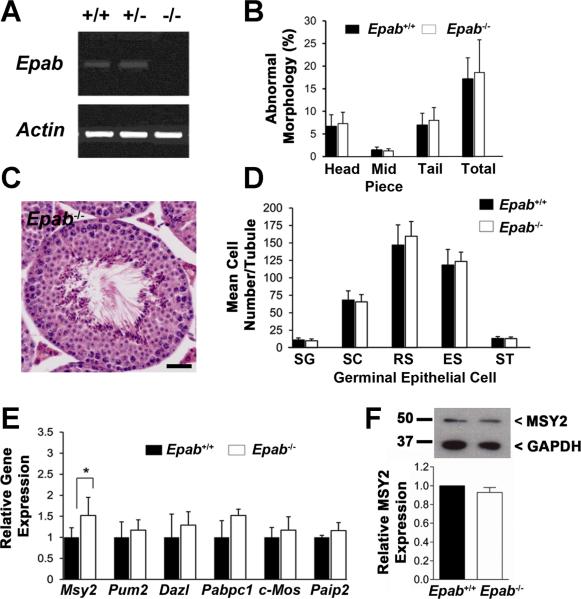During spermatogenesis, gene expression is regulated post-transcriptionally by modification of the poly-adenine (poly(A)) tail length of repressed mRNAs. In a previous study, we demonstrated that the expression of two mRNA binding proteins, embryonic poly(A)-binding protein (EPAB), and somatic cytoplasmic poly(A)-binding protein (PABPC1), is spatially and temporally controlled during male germ-cell development, suggesting that they may modulate gene expression in different spermatogenic cell types (Ozturk et al., 2012).
We therefore evaluated the fertility of homozygous Epab knockout male mice (Epab−/−) to further define the importance of EPAB during spermato-genesis. Epab−/− mice were generated by targeted deletion of Epab exon 2, as described previously(Guzeloglu-Kayisli et al., 2012). The absence of exon 2 generates a stop codon in exon 3, and consequently encodes a truncated EPAB protein product that contains only part of the first RNA recognition motif (RRM) and lacks the remaining three RRMs and the PAPC domain. Reverse-transcription PCR (Fig. 1A) and RNA in situ hybridization (not shown) were used to confirm the absence of full-length Epab transcripts in the testis of Epab−/− males. Epab−/− males are viable, phenotypically normal, and do not exhibit differences in weight as compared to their wild-type (Epab+/+), and heterozygous knockout (Epab+/− ) littermates.
Figure 1.
EPAB is dispensable for spermatogenesis. A: PCR amplification of Epab from cDNA confirm that exon 2 is properly deleted in Epab−/− testes. β-Actin was used as a loading control. B: The percentage of sperm cells with head, mid-piece, and tail defects. Results are presented as the mean ± standard deviation. C: Representative image of hematoxyline- and-eosine-stained Epab−/− testis section. Scale bar, 25 mm. D: The number of germinal epithelial cells in the seminiferous tubules of Epab+/+ and Epab−/− male testes (spermatogonia (SG), spermatocytes (SC), round spermatid (RS), elongated spermatid (ES), Sertoli cell (ST)). Results are presented as the mean ± standard deviation. E: mRNA expression of Msy2, Pum2, Dazl, Pabpc1, c-Mos, and Paip2 from Epab+/+ and Epab−/− testes using quantitative reverse-transcriptase PCR, and normalized to β-actin. * Indicates statistical significance, as determined by Mann –Whitney U-test (P < 0.05). Results are presented as fold change standard deviation. F: Msy protein levels in testis lysate by Western blot analysis. Bands were quantified using densitometry, and normalized to GAPDH.
The fertility of Epab+/+, Epab+/− , and Epab−/− male mice was tested by mating with wild-type females of proven fertility (male:female ratio of 1:2), for a total of 20 weeks (minimum of four oestrus cycles with each male). Epab−/− male mice produced a similar number of pups compared to wild-type and heterozygous breeding males. Additional fertility parameters– –including, testis weight, sperm count, and morphology, motility, and apoptosis index––were all normal in Epab−/− males (data not shown).
Furthermore, Epab−/− males exhibit normal seminiferous tubule structure and complete spermatogenesis, as determined by histological analysis (Fig. 1B–D). In contrast to its essential role in female fertility (Guzeloglu-Kayisli et al., 2012), these results demonstrate that EPAB is not required for spermatogenic functions in male mice.
It is possible that Epab is important for male fertility, but its loss is compensated for by the action of other RNA binding proteins, such as MSY2, DAZL, PUM2, or PAPBC1. We therefore used quantitative reverse-transcription PCR to measure the transcript levels of these RNA binding proteins, as well as the kinase c-Mos, in the testes of Epab+/+, and Epab−/− males (Fig. 1E). We found that Msy2 mRNA expression increased significantly by 50% as a result of Epab deletion (P < 0.05). Msy2 is exclusively expressed in germ cells, is essential for male and female fertility (Yang et al., 2005), and could compensate for the loss of Epab. Yet MSY2 protein levels were similar in Epab+/+ and Epab−/− male testes, as observed for the other proteins examined.
In summary, our findings demonstrate that EPAB is dispensable for male fertility in mice. Although the expression of Epab is spatially and temporally regulated during spermatogenesis, we did not detect any defects in male fertility parameters in Epab−/− males as compared to wild-type males. We conclude that either EPAB is not important for male fertility, or that the phenotype associated with the loss of EPAB is masked by another protein. Since post-transcriptional gene expression is essential at several steps during male germ-cell development, it is likely that multiple, redundant mechanisms have evolved to control translational activation and repression.
Acknowledgments
Grant sponsor: National Institute of Health (NIH); Grant number: K08 HD046581-01; Grant number: R01HD059909; Grant sponsor: National Center for Advancing Translational Sciences (NCATS); Grant number: UL1 RR024139.
REFERENCES
- Guzeloglu-Kayisli O, Lalioti MD, Aydiner F, Sasson I, Ilbay O, Sakkas D, Lowther KM, Mehlmann LM, Seli E. Embryonic poly(A)-binding protein (EPAB) is required for oocyte maturation and female fertility in mice. Biochem J. 2012;446:47–58. doi: 10.1042/BJ20120467. [DOI] [PMC free article] [PubMed] [Google Scholar]
- Ozturk S, Guzeloglu-Kayisli O, Demir N, Sozen B, Ilbay O, Lalioti MD, Seli E. Epab and Pabpc1 are differentially expressed during male germ cell development. Reprod Sci. 2012;19:911–922. doi: 10.1177/1933719112446086. [DOI] [PMC free article] [PubMed] [Google Scholar]
- Yang J, Medvedev S, Yu J, Tang LC, Agno JE, Matzuk MM, Schultz RM, Hecht NB. Absence of the DNA-/RNA-binding protein MSY2 results in male and female infertility. Proc Natl Acad Sci USA. 2005;102:5755–5760. doi: 10.1073/pnas.0408718102. [DOI] [PMC free article] [PubMed] [Google Scholar]



